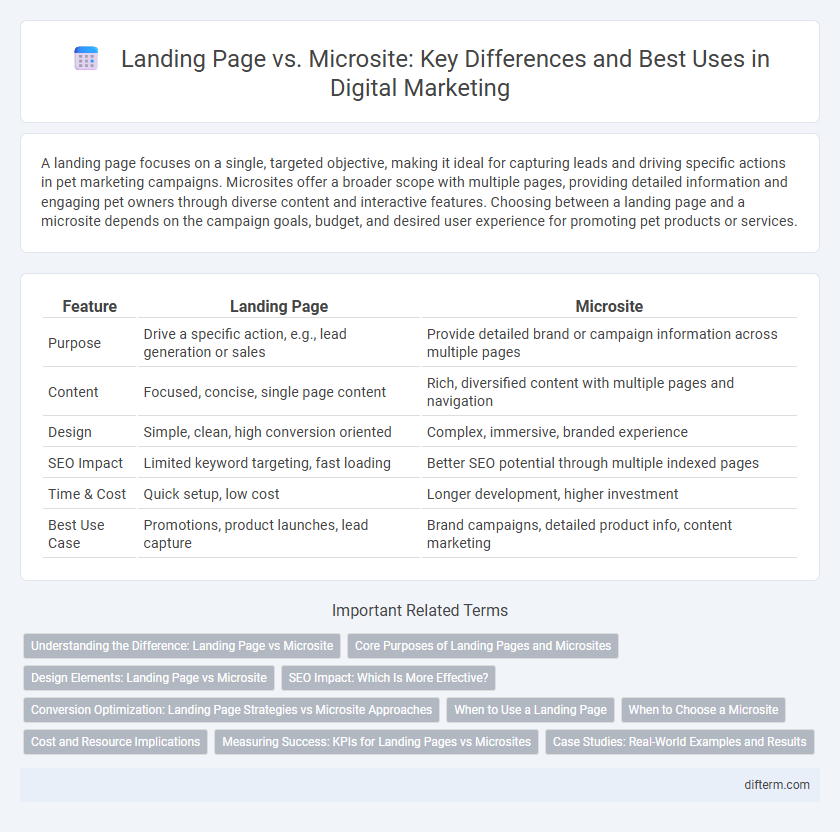A landing page focuses on a single, targeted objective, making it ideal for capturing leads and driving specific actions in pet marketing campaigns. Microsites offer a broader scope with multiple pages, providing detailed information and engaging pet owners through diverse content and interactive features. Choosing between a landing page and a microsite depends on the campaign goals, budget, and desired user experience for promoting pet products or services.
Table of Comparison
| Feature | Landing Page | Microsite |
|---|---|---|
| Purpose | Drive a specific action, e.g., lead generation or sales | Provide detailed brand or campaign information across multiple pages |
| Content | Focused, concise, single page content | Rich, diversified content with multiple pages and navigation |
| Design | Simple, clean, high conversion oriented | Complex, immersive, branded experience |
| SEO Impact | Limited keyword targeting, fast loading | Better SEO potential through multiple indexed pages |
| Time & Cost | Quick setup, low cost | Longer development, higher investment |
| Best Use Case | Promotions, product launches, lead capture | Brand campaigns, detailed product info, content marketing |
Understanding the Difference: Landing Page vs Microsite
A landing page targets a specific campaign or audience with a single, focused call-to-action, optimizing conversion rates by minimizing distractions. In contrast, a microsite serves as a small, standalone website with multiple pages, designed to provide broader content or support a brand initiative. Understanding the difference enables marketers to choose the appropriate format for lead generation, brand engagement, or product launches.
Core Purposes of Landing Pages and Microsites
Landing pages are designed primarily to drive specific actions such as lead generation, product purchases, or event registrations by providing focused content and clear calls-to-action. Microsites serve as smaller, branded websites that offer in-depth information on a particular campaign, product line, or event, allowing for a richer storytelling experience and increased user engagement. Both tools optimize marketing strategies by targeting distinct customer journeys--landing pages streamline conversions while microsites enhance brand awareness and detailed education.
Design Elements: Landing Page vs Microsite
Landing pages emphasize minimalist design elements with clear calls-to-action, focusing on a single objective to maximize conversion rates. Microsites incorporate diverse, interactive design components that support storytelling and brand engagement across multiple pages. Both leverage responsive layouts, but microsites allow for richer multimedia and navigation features, enhancing user experience and information depth.
SEO Impact: Which Is More Effective?
Landing pages often outperform microsites in SEO due to their focused content and targeted keyword optimization that enhances page authority and user relevance. Microsites can dilute SEO efforts by spreading backlinks and traffic across multiple domains, reducing the overall impact on search rankings. Concentrated link equity and clear, specific meta tags on landing pages drive higher organic visibility and conversion rates compared to microsites.
Conversion Optimization: Landing Page Strategies vs Microsite Approaches
Landing pages optimize conversion by focusing on a single, clear call-to-action with minimal distractions, leveraging targeted messaging and A/B testing to increase user engagement and lead capture. Microsites offer broader storytelling and multiple interactive elements to nurture prospects through various stages of the sales funnel, ideal for brand campaigns or product launches requiring extensive information. Choosing between landing pages and microsites depends on campaign goals, where landing pages drive immediate actions and microsites support deeper user exploration and brand affinity.
When to Use a Landing Page
A landing page is ideal for targeted marketing campaigns focused on a single call-to-action, such as lead generation, product promotion, or event registration. It enhances conversion rates by offering a distraction-free experience tailored to specific audience segments. Use a landing page when quick results and clear user direction are critical in driving marketing objectives.
When to Choose a Microsite
Choose a microsite when targeting a specific audience or campaign with focused content that requires isolation from your main website to enhance user experience and conversion rates. Microsites provide flexibility in design and messaging, making them ideal for product launches, events, or segmented marketing strategies. Their ability to operate independently allows detailed tracking and tailored SEO benefits for niche keywords.
Cost and Resource Implications
Landing pages typically require lower development costs and fewer resources, making them ideal for quick campaigns and targeted lead generation. Microsites demand higher investment due to their expanded content, multiple pages, and ongoing maintenance needs, often requiring cross-functional collaboration from design, development, and content teams. Businesses must weigh the budget constraints and resource availability against campaign complexity to determine the most efficient option for their marketing strategy.
Measuring Success: KPIs for Landing Pages vs Microsites
Measuring success for landing pages primarily involves KPIs such as conversion rate, bounce rate, and click-through rate, which directly reflect user engagement and lead generation effectiveness. Microsites require a broader set of KPIs including average session duration, page views per visit, and brand recall metrics to evaluate multi-page interaction and overall brand impact. Tracking goal completions and user flow through both formats provides critical insights into campaign performance and optimization opportunities.
Case Studies: Real-World Examples and Results
Case studies comparing landing pages and microsites reveal that landing pages drive higher conversion rates for targeted campaigns, with average conversion improvements of 20-30% due to focused messaging and clear calls-to-action. Microsites excel in brand storytelling and customer engagement, often increasing time spent on site by over 40% through interactive content and multi-dimensional navigation. Marketers leverage these insights to choose landing pages for direct response campaigns and microsites for brand awareness and lead nurturing strategies.
Landing Page vs Microsite Infographic

 difterm.com
difterm.com